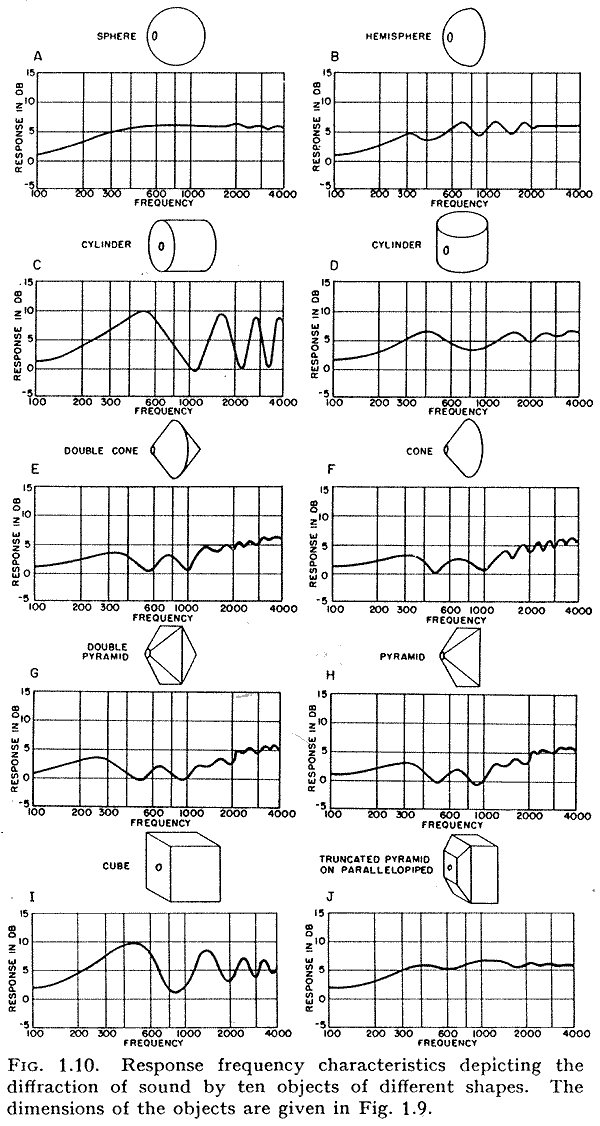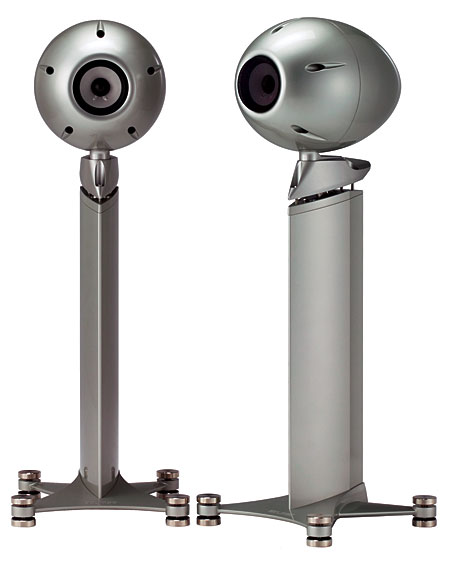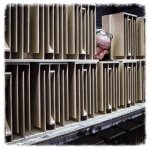Why not go a bit bigger driver?Hence (repeated - sorry...)
View attachment 1077288
But I plan for a small coax - like the 4" SB perhaps...
//
Edge rounding helps but sphere betterYeah diffraction happens when wavelength is about the size of the object and its on all waves like water, light, gravitation etc 😉 but the effects can be changed, round the edge to reduce the secondary sound source and enjoy problem free diffraction.
Yes, edge rounding makes poor sphere, I mean a relatively small one. The bigger the roundover radius the more sphere you get.
Think 20cm cube for example, 10cm radius roundovers would make it a sphere. Thats big enough of a radius roundover not to show diffraction related interference anymore for 20cm wavelength. Quarter of that would have some effect, 1" radius, but 1/10th or 1cm radius is probably not going to make much of a difference for 20cm wavelength. However even the 1cm radius roundover would be very effective for 2cm wavelength and show as little diffraction interference as a 2cm radius sphere. Or 1" radius roundover to 2" wavelength, etc. For 200Hz wide baffle one would need 400Hz radius roundovers 😀 Effects appear the same as long as ratio between wavelength and object/feature size stays the same.
In practice wavelength varies, a lot, but our physical speakers stay the same size, as they are inanimate objects so better plan the size (and shape) so it works for most of the bandwidth, especially where hearing system notices diffraction. I have no idea where it would be so it makes sense just to minimize it. If sphere is not practical, then as big roundovers as fits. If you are lazy like me make a box so small no roundover fits so you don't have to make one 🙂 Then crossover to a 3D/CNC manufactured waveguide that has them and let it handle the issue.
Think 20cm cube for example, 10cm radius roundovers would make it a sphere. Thats big enough of a radius roundover not to show diffraction related interference anymore for 20cm wavelength. Quarter of that would have some effect, 1" radius, but 1/10th or 1cm radius is probably not going to make much of a difference for 20cm wavelength. However even the 1cm radius roundover would be very effective for 2cm wavelength and show as little diffraction interference as a 2cm radius sphere. Or 1" radius roundover to 2" wavelength, etc. For 200Hz wide baffle one would need 400Hz radius roundovers 😀 Effects appear the same as long as ratio between wavelength and object/feature size stays the same.
In practice wavelength varies, a lot, but our physical speakers stay the same size, as they are inanimate objects so better plan the size (and shape) so it works for most of the bandwidth, especially where hearing system notices diffraction. I have no idea where it would be so it makes sense just to minimize it. If sphere is not practical, then as big roundovers as fits. If you are lazy like me make a box so small no roundover fits so you don't have to make one 🙂 Then crossover to a 3D/CNC manufactured waveguide that has them and let it handle the issue.
Last edited:
Haven't visited this thread for a while and re-read a lot of the more technical and recent posts on diffraction, and how to really evaluate its effect on the speakers overall sound. Have there been A-B comparisons done between some kind of "box" design (with rounded edges) and the same exact components in a spherical set up? The volume especially for the bass driver would want to be similar. Would think playing some of your favorite music to eval a speaker with a blindfold on, and A-B, would provide some insights? Of course use same listening room and similar speaker placements.
Have there been A-B comparisons done between some kind of "box" design (with rounded edges) and the same exact components in a spherical set up?
Not quite that far. A CGR Mar-Ken12p (rectangular box) vrs the same alignment in the trapezoid (8-sdided with significant chamfers). The more “spherical” box had a much greater tendency to disappear.
dave
With less diffraction effects - the prize of less being the ability of speakers to disappear - why don't more folks do this?
Because it is harder.
There are 3 basic versions of the miniOnken, and as each improves the minimization of external diffraction, the box build becomes a more difficult challenge.
Making roundish things with sheet material.
dave
There are 3 basic versions of the miniOnken, and as each improves the minimization of external diffraction, the box build becomes a more difficult challenge.
Making roundish things with sheet material.
dave
I meant why isn't there more research and listening evaluations (by whomever might be appropriate and/or influential) using actual A-B versions of the same "innards" in box (more diffraction) vs. spherical (less diffraction) designs? Ultimately one buys what sounds good after looking at all the specs, and if spheres often sound better and more spatial, getting user input should be valuable. They are harder to make, but a lot of higher end "box" stuff is not straightforward either.
Perhaps the difference is not that evident, perhaps people don't mind, perhaps they don't know, perhaps its a problem on a loud listening level, perhaps there is so much stuff in the room close to speakers like tv or a bookshelf, aesthetics. I don't know, would have to make two versions as you suggest. Basically it has to be a box with low and high diffraction sleeve otherwise the innards would change as well, or outer dimensions, and it would be hard to isolate the issue.
Definitely have got my speakers to disappear but haven't bothered to do bad diffraction version to check out 😉 and its not even spherical speaker, just roundovers that fit.
I think its not diffraction alone that needs to be in line, resonances could reveal the speaker as well, environment, coherence of sound from both sides. Make simple test, feed mono signal like white noise to both speakers and listen if you have solid center phantom image. If there is some hash on either speaker you need EQ or some other stuff to make all of it in the phantom center. Now the speakers have disappeared.
So I think answer to question why there isn't more evaluations is that its tedious work and not many are willing to do that. If you are serious about your system there is no point to neglect diffraction or overshoot with it, just find good system balance among all other issues and design criteria you might have and thats it. A problem free system is the goal.
Definitely have got my speakers to disappear but haven't bothered to do bad diffraction version to check out 😉 and its not even spherical speaker, just roundovers that fit.
I think its not diffraction alone that needs to be in line, resonances could reveal the speaker as well, environment, coherence of sound from both sides. Make simple test, feed mono signal like white noise to both speakers and listen if you have solid center phantom image. If there is some hash on either speaker you need EQ or some other stuff to make all of it in the phantom center. Now the speakers have disappeared.
So I think answer to question why there isn't more evaluations is that its tedious work and not many are willing to do that. If you are serious about your system there is no point to neglect diffraction or overshoot with it, just find good system balance among all other issues and design criteria you might have and thats it. A problem free system is the goal.
Yes ,. Round or oval designs are great at reducing standing waves. Remember the Focal egg shape design. They used alot of inverted domes. Never understood the advantage. Expensive too. Probably hype. Think they were fiber glass. Maybe extruded plasic? Generac or something like that does oval designs. Made one out of concrete. Don't try it it's was hard the attach Drivers and looks awful?Not quite that far. A CGR Mar-Ken12p (rectangular box) vrs the same alignment in the trapezoid (8-sdided with significant chamfers). The more “spherical” box had a much greater tendency to disappear.
dave
If this thread hasn't been mentioned...
https://www.diyaudio.com/community/threads/jordan-eikona-translam-ellipsoid.358812/#post-6310421
https://www.diyaudio.com/community/threads/jordan-eikona-translam-ellipsoid.358812/#post-6310421
Focal, Eclipse, Mach 17.
Standing waves are inside, a sphere has the worst, in the miniOnkens the tapered enclosure has a tiny bit of spread/help but the prime purpose is dealing with outside air flow.
dave
Standing waves are inside, a sphere has the worst, in the miniOnkens the tapered enclosure has a tiny bit of spread/help but the prime purpose is dealing with outside air flow.
dave
Guess I was misinformed. Get the out wave having less diffraction and baffle step. Am I wrong again? You know way more than most from what you have already corrected me about audio stuff of all kinds. Good to have a solid real audiophile. My Voigt I made is supposed to help diminishe standing wave with some half or quarter wave length cancellation or suppression. I really think the Voigt design is underutilized.. probably because it is so big.
Last edited by a moderator:
Because it is harder.
Plus the vast majority of folks prefer a 'lively' speaker (box) as 'soundly' proven by the world's most successful consumer speaker builder and IME due to the vast majority of the DIY designs I've done with feedback other than Altec replicas is that no matter how little internal damping I used it's almost always too much.
The one that stunned me though was a huge ~32 ft^3 6+ ft tall Altec 515B MLTL for a couple that had lifelong front row center seats at Rome, Italy's most prominent opera house and they weren't satisfied that it did a 'good enough' live reproduction until he'd had it gutted!
To reduce standing waves one needs significantly varying distances inside the enclosure, the greater the distribution of internal enclosure distances the more one supresses standing waves. A sphere has one distance and one giant internal standing wave, one can largely deal with that with an obstruction, heavy damping dead-centre.

A middle size trapezoidal miniOnken has a spread of about 0.6 of an octave (relative delta gets larger as boxes get smaller). The height could have a standing wave.

The holey brace has a greater impact on side-to-side distances, the holes allowing full width, the solid parts a bit less than half. This is taken to extremes in this larger version — note that the holes in the braces do not line up to create significantly large distribution of distances in the horizontal directions.

When we talk about diffraction we are typically taking about the cabinet’s shape on the sound front. The expression of this changes with frequency. At high frequencies we get edge diffraction at a sharp boundary, at lower frequencies we get baffle dtep diffraction, which on the face of it is a 6dB loss of on-axis response as the wavefronts transition from 2π 4π transition as the size of the baffle decreases relative to the wavelength under consideration, But this roll-off has a shape which is dependent on the enclosure shape and this is where we see the classic Olson chart.

B&W took this research further and we end up with this shape:

Eclipse speakersare similar, an egg or ellipsoid is the simple shape. Teardrop a bit more complex.

With 3D printing we should see these shapes become more common in DIY loudspeakers.
dave

A middle size trapezoidal miniOnken has a spread of about 0.6 of an octave (relative delta gets larger as boxes get smaller). The height could have a standing wave.

The holey brace has a greater impact on side-to-side distances, the holes allowing full width, the solid parts a bit less than half. This is taken to extremes in this larger version — note that the holes in the braces do not line up to create significantly large distribution of distances in the horizontal directions.

When we talk about diffraction we are typically taking about the cabinet’s shape on the sound front. The expression of this changes with frequency. At high frequencies we get edge diffraction at a sharp boundary, at lower frequencies we get baffle dtep diffraction, which on the face of it is a 6dB loss of on-axis response as the wavefronts transition from 2π 4π transition as the size of the baffle decreases relative to the wavelength under consideration, But this roll-off has a shape which is dependent on the enclosure shape and this is where we see the classic Olson chart.

B&W took this research further and we end up with this shape:

Eclipse speakersare similar, an egg or ellipsoid is the simple shape. Teardrop a bit more complex.

With 3D printing we should see these shapes become more common in DIY loudspeakers.
dave
"reduce standing waves one needs significantly varying distances inside the enclosure, the greater the distribution of internal enclosure distances the more one suppresses standing waves."
Done Morrison does something like this with his enclosure.
https://www.morrisonaudio.com/
Done Morrison does something like this with his enclosure.
https://www.morrisonaudio.com/
Attachments
Thanks for the engineering education. I've had alot of engineering education that has served me well. Used quite a bit dismantling a double garage door on our money pit home. Putting in double doors.full glass triple pain. Insanely heavy. Any way you Shure cleared some things up. Especially with pictures. Yes I see how all the individual small sections would reflect and diminishe sound transfer. Good to have someone like you aboardTo reduce standing waves one needs significantly varying distances inside the enclosure, the greater the distribution of internal enclosure distances the more one supresses standing waves. A sphere has one distance and one giant internal standing wave, one can largely deal with that with an obstruction, heavy damping dead-centre.

A middle size trapezoidal miniOnken has a spread of about 0.6 of an octave (relative delta gets larger as boxes get smaller). The height could have a standing wave.

The holey brace has a greater impact on side-to-side distances, the holes allowing full width, the solid parts a bit less than half. This is taken to extremes in this larger version — note that the holes in the braces do not line up to create significantly large distribution of distances in the horizontal directions.

When we talk about diffraction we are typically taking about the cabinet’s shape on the sound front. The expression of this changes with frequency. At high frequencies we get edge diffraction at a sharp boundary, at lower frequencies we get baffle dtep diffraction, which on the face of it is a 6dB loss of on-axis response as the wavefronts transition from 2π 4π transition as the size of the baffle decreases relative to the wavelength under consideration, But this roll-off has a shape which is dependent on the enclosure shape and this is where we see the classic Olson chart.

B&W took this research further and we end up with this shape:

Eclipse speakersare similar, an egg or ellipsoid is the simple shape. Teardrop a bit more complex.

With 3D printing we should see these shapes become more common in DIY loudspeakers.
dave
…morrisonaudio...
Carrying the work of Hegeman forward.
I’d like to hear his loudspeakers. I did stick my head into a Hegeman 1. :^)
dave
That was interesting info. Looked over it again and seems like the truncated pyramid looks pretty flat and easy enough to build out of wood. Will build a small one with good internal wave refection properties. Will use point source Dayton PS 95 3" driver. It's an inexpensive driver that's great for small rooms. Forget phase and cover problems.To reduce standing waves one needs significantly varying distances inside the enclosure, the greater the distribution of internal enclosure distances the more one supresses standing waves. A sphere has one distance and one giant internal standing wave, one can largely deal with that with an obstruction, heavy damping dead-centre.

A middle size trapezoidal miniOnken has a spread of about 0.6 of an octave (relative delta gets larger as boxes get smaller). The height could have a standing wave.

The holey brace has a greater impact on side-to-side distances, the holes allowing full width, the solid parts a bit less than half. This is taken to extremes in this larger version — note that the holes in the braces do not line up to create significantly large distribution of distances in the horizontal directions.

When we talk about diffraction we are typically taking about the cabinet’s shape on the sound front. The expression of this changes with frequency. At high frequencies we get edge diffraction at a sharp boundary, at lower frequencies we get baffle dtep diffraction, which on the face of it is a 6dB loss of on-axis response as the wavefronts transition from 2π 4π transition as the size of the baffle decreases relative to the wavelength under consideration, But this roll-off has a shape which is dependent on the enclosure shape and this is where we see the classic Olson chart.

B&W took this research further and we end up with this shape:

Eclipse speakersare similar, an egg or ellipsoid is the simple shape. Teardrop a bit more complex.

With 3D printing we should see these shapes become more common in DIY loudspeakers.
dave
3" driver
Fostex FF85wk and Markaudio lpair 5.2/3 or CHN-50 ar emy favorite 3”
dave
- Home
- Loudspeakers
- Multi-Way
- How to build a spherical speaker?
